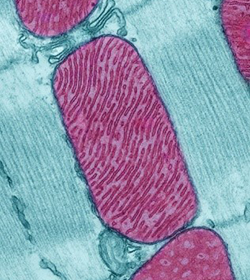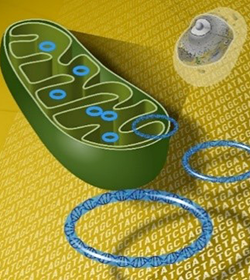 Mitochondria (purple) in a rodent heart muscle cell. Credit: Thomas Deerinck, National Center for Microscopy and Imaging Research.
Mitochondria (purple) in a rodent heart muscle cell. Credit: Thomas Deerinck, National Center for Microscopy and Imaging Research.
Mitochondria (mitochondrion in singular) are indispensable. Every cell of our bodies, apart from mature red blood cells, contains the capsule-shaped organelles that generate more than 90 percent of our energy, which is why they’re often called “the powerhouse of the cell.” They produce this energy by forming adenosine triphosphate (ATP), our cells’ most common energy source. But mitochondria also support cells in other ways. For example, they help cells maintain the correct concentration of calcium ions, which are involved in blood clotting and muscle contraction. Mitochondria are also the only structure in our cells with their own unique DNA, which with rare exceptions, is inherited only from mothers. That’s why, in honor of Mother’s Day, we’re exploring this special cellular connection to moms.
Mitochondrial DNA Basics
Most scientists believe that mitochondria have their own DNA because they originated as free-living bacteria that were engulfed by primitive eukaryotic cells but not digested about 1.5 billion years ago. Instead, the two cells benefited each other and eventually developed a relationship that would evolve into more complex life, such as plants and animals.
 Mitochondrial DNA forms circles, unlike the rest of our DNA. Credit: National Human Genome Research Institute.
Mitochondrial DNA forms circles, unlike the rest of our DNA. Credit: National Human Genome Research Institute.
Mitochondria’s involvement in cellular processes requires direction from both the DNA found in our cells’ nuclei and mitochondrial DNA. Mitochondrial DNA forms a circle and contains 37 genes. This makes it tiny compared to our nuclear DNA, which contains about 20,000 genes.
Mitochondrial genes provide instructions for building proteins and RNA molecules that are essential to mitochondria’s function. Although they can multiply independently of their cell, mitochondria have been part of other cells for so long that they can’t function correctly without nuclear DNA because it contains the instructions for many proteins they need. Errors in the nuclear DNA genes for these proteins or in mitochondrial DNA can cause rare, severe disorders called mitochondrial diseases. Abnormal mitochondria have also been linked to more common diseases, including several associated with aging.
Mitochondria as a Maternal Inheritance
Unlike nuclear DNA, which is inherited from both parents, mitochondrial DNA is usually inherited only from our mothers. Both egg and sperm cells contain mitochondria with mitochondrial DNA, but after fertilization the mitochondria from the sperm are almost always destroyed. Mitochondrial DNA changes very little across generations, so scientists can use it to trace maternal lineage through hundreds of thousands of years. Some studies have looked at the mitochondrial DNA of modern-day populations to help determine the migration patterns of early humans after they left Africa.
Mitochondrial DNA can be helpful for other investigations, too, such as identifying human remains when researchers don’t have DNA from the person they’re searching for but do have access to family members’ DNA. For example, Russia’s last ruling family, the Romanovs, were executed and buried in unmarked graves during the Russian Revolution, and mitochondrial DNA played a key role in identifying their remains more than 75 years later.
NIGMS Support of Mitochondria Research
Currently, NIGMS funds many scientists who study mitochondria and their DNA. Research ranges from how these organelles synthesize proteins to how they’re altered in diseases associated with aging. These studies will increase our understanding of mitochondria and could ultimately help find treatments for some diseases.


do you know if mitochondria problems has anything to do with extremely low energy c f s i’m told i have
Thank you for your interest in our post on mitochondria, Manuel. We’re sorry to hear that you have chronic fatigue syndrome. You can find more information and resources about chronic fatigue syndrome at MedlinePlus. You may be interested in contacting the National Institute of Neurological Disorders and Stroke, which leads NIH research efforts on this condition. We hope this is helpful.
Nice!
Novel aspect of mitochondria learnt
Very good article